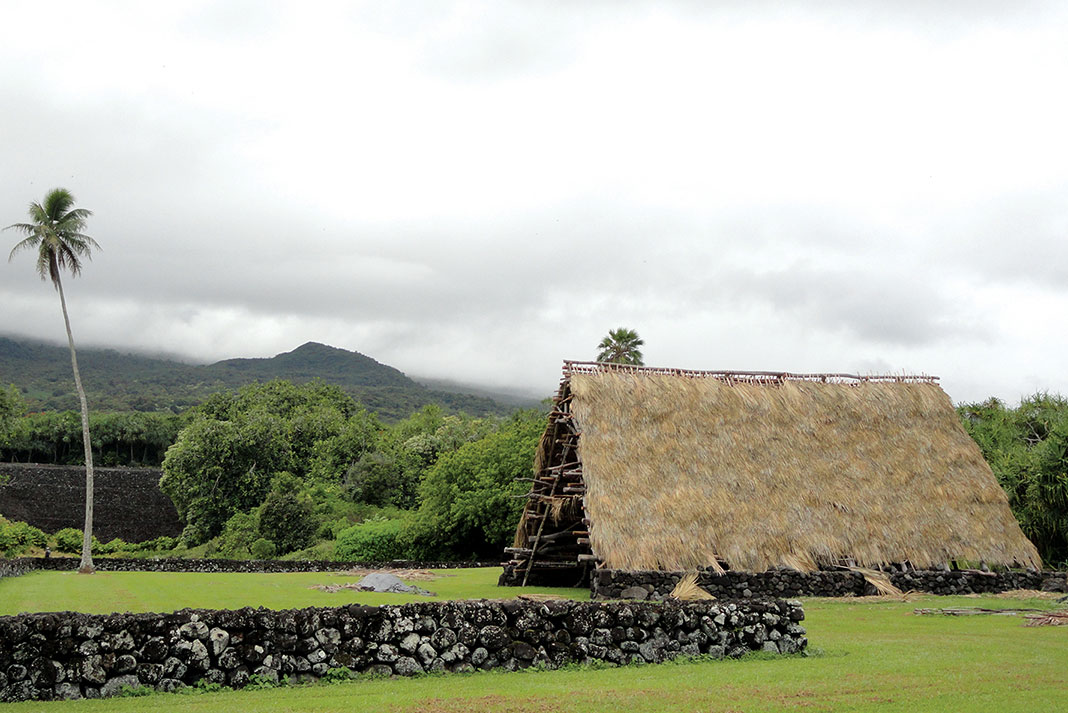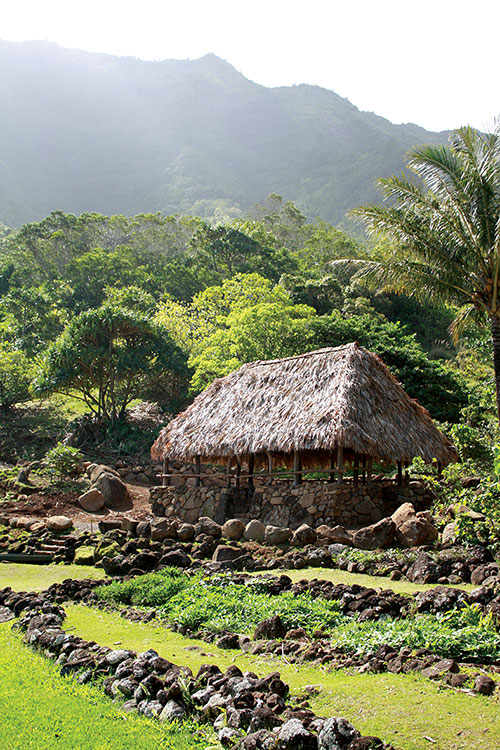Hawaiian Homes
PART 4 OF A 5-PART SERIES ON HAWAIIAN TECHNOLOGY AND SCIENCE
1 | 2 | 3 | 4 | 5
Story by Judy Edwards
WEB EXCLUSIVE: Watch a Hawaiian hale’s construction
According to the Hawaiian scholar and historian Samuel Kamakau (1815–1876), three things were necessary for the well-being of the Hawaiian people. One was the canoe, the wa‘a, for travel, food, and warfare. A second was the land, the ‘āina, for the cultivation of kalo (taro). The third was the hale, the sheltering structure that not only protected the people from the elements, but also helped to define their social life.

Most current references to “Hawaiian architecture” are really about post-Contact Western structures imported to Hawai‘i and modified to better fit the climate. Internal walls were removed, ceilings lifted, foundations raised, and windows added or widened, all to channel and maximize the daily breezes. Builders extended rooflines to divert the rain away from open windows, and the widened porches (lānai) allowed for a gradual transition from inside to outside. This natural tendency in a mild climate to bring indoor life out, and outdoor light and air in, is how Hawaiian communities lived for hundreds of generations before Westerners arrived in the 1800s with more “civilized” ideas about housing. It is ironic, or maybe poetic, that the old lifestyle designs—an organic response to the reality that much of Hawaiian daily life is more pleasant when conducted outdoors—are new again.
 Imagine a star-saturated night a thousand years ago on Maui. In the hale noa (sleeping house), the entire extended family dreamed on soft, scented kapa mats spread over a base flooring of smooth, water-rounded ‘ili‘ili stones. A small fire burned throughout the night, with someone replenishing it now and again. Cool air flowed in the low, open door, or through “windows” made by pushing the fragrant, bundled, pili-grass thatching aside. If the rains came, the tight thatching shed water easily, and the hale noa’s stone platform ensured a dry floor.
Imagine a star-saturated night a thousand years ago on Maui. In the hale noa (sleeping house), the entire extended family dreamed on soft, scented kapa mats spread over a base flooring of smooth, water-rounded ‘ili‘ili stones. A small fire burned throughout the night, with someone replenishing it now and again. Cool air flowed in the low, open door, or through “windows” made by pushing the fragrant, bundled, pili-grass thatching aside. If the rains came, the tight thatching shed water easily, and the hale noa’s stone platform ensured a dry floor.
At sunrise, family members woke to begin the day’s duties. The kapu system of societal laws divided many tasks by gender, and in the orderly life of pre-Contact Hawai‘i, a duty often required its own hale. The hale noa was the only shelter where men and women mixed freely. Males alone entered the hale mua, the men’s meetinghouse. Men also tended the hale kuke, the cooking house, from which they carried food to the hale ‘āina, where the women and young children ate. Making kapa (barkcloth) was women’s work; the structure in which they beat and dried the bark was the hale ku‘a. And during their menses, women stayed in a separate structure, called the hale pe‘a. Smaller hale for storing tools, instruments, food, and other valuables were constructed as needed. The whole homey cluster of structures comprised the kauhale (homestead). Footpaths wound among the hale, which were situated to make maximum use of airflow, light, rainfall, and proximity to fresh and salt water.
Builders chose the woods for the various hale from the immediate area, and sorted them for their different properties: strength for support poles, flexibility for the roof poles so that the structure would breathe, and bend in extreme weather without pulling apart. Sweet-smelling, rain-repelling pili grass was preferred for thatching, but palm fronds would serve, too. All those who could help build, did, and welcomed new hale with prayers and ceremony, the most important part of which was the cutting of the tuft of grass at the roof peak, symbolizing the cutting of the piko, or umbilical cord.






Come Laulima with us bubba
I am an Artisan at Waimea Falls and am interested in hale building (certified). I currently work under the direction of Ka’ulamealani Papa Diamond. I would like to ask if there is any way A step by step guide on traditional thatching(knots) methods can be sent to either myself or Ka’ula at Waimea Falls. I am currently familiar with 3 tying methods as I have worked on the Hale O Lono project from start to finish. Mahalo nui for taking the time to read as well as consider my request.